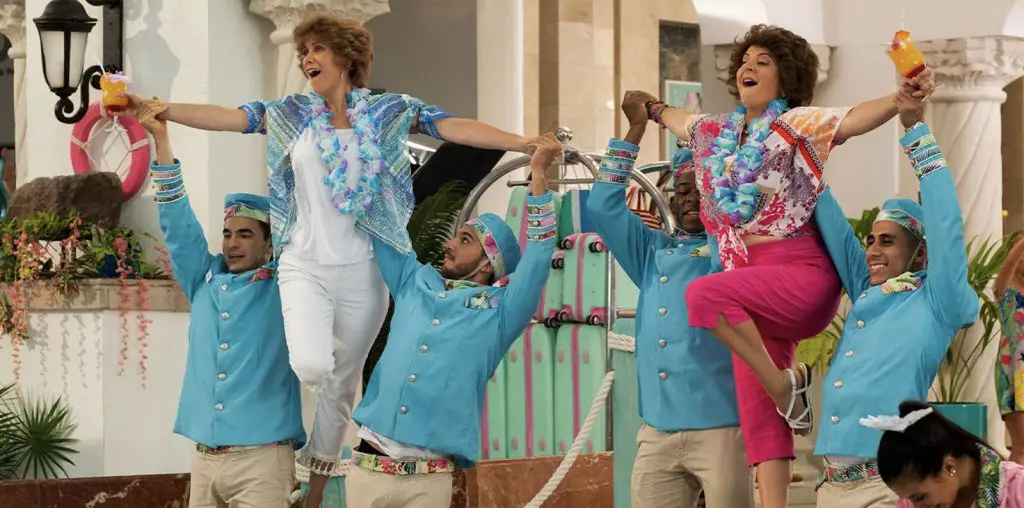
One of the most notable things about “Once Upon a Time In Mexico,” from a filmmaking standpoint, is that this is one of the first movies to be shot on the same high definition 24p digital video cameras used for Star Wars: Episode 2. (It was actually finished shooting in 2001, but held for 2 years for release.) Rodriguez also shot his Spy Kids sequels with the same technology, but what makes “Mexico” so important is that it is a gritty film without all the gee-whiz special effects seen in Spy Kids or the overdone post production in the “Star Wars” movies.
Supposedly, Rodriguez used “Once Upon a Time In Mexico” to push the limits of the new digital cameras, experimenting with lenses, filters and frame rates. To his credit, he did an excellent job with this. Many of the scenes really look like film, and there were only two shots in which the video image appreciatively broke down (and both of those were in extremely wide, deep shots). Sure, there are still video artifacting in hot spots on the image, but overall this movie could be an advertisement for the 24p digital video camera.
But there’s one aspect to this whole digital video issue that just needs to be called onto the carpet. Even Rodriguez couldn’t help but fall into the ludicrous trap of not calling this a film because it was shot on video. (He calls it “A Robert Rodriguez Flick” in the opening credits.)
Give me a f*****g break! I dare anyone to call up David Tattersall, the director of photography on the new “Star Wars” films, and tell him he isn’t a real filmmaker because he didn’t shoot the movie on actual film. Heck, I’m a professional writer, but by this standard, I haven’t technically “written” anything in years. I use a computer, so why don’t people demand that I call myself a typer or a word processor?
Just call it a film, Rob, and get on with your career. In my experience from dealing with independent filmmakers, the only folks that really make a big deal about this sort of thing are talentless hacks who use the fact that they shoot on film as a replacement for quality in their product.
The bottom line is that Robert Rodriguez had the budget to shoot on either film or video. It was his choice. Many independents would love to shoot on film, but just can’t afford it. And if they choose video for budgetary reasons, they sure as heck ain’t gonna afford the same gear that Rodriguez had on this $30 million “flick.” A Sony Handycam isn’t gonna cut it. The proper video equipment, filters, lenses and shooting experience is going to cost the independent filmmaker a chunk of change – arguably more than it would to shoot their movie on good old 16mm.
Okay, enough with the technical mumbo-jumbo. Let’s take a look at the story.
El Mariachi (Antonio Banderas), the gun-toting guitar player from “Desperado,” has gone into retirement after a nasty run-in with a Mexican general. However, the corrupt CIA agent, Sands (Johnny Depp), digs him up from the Mexican underground for his own scheme. Using his connections to the Mexican government, the FBI and other nefarious characters, Sands intends to purify the political system with an assassination attempt and a double-cross to walk away with 200 million pesos (about $20 million American). Of course, El Mariachi is not that easily controlled.
My biggest beef with “Once Upon a Time in Mexico” is that the plot was extremely murky and convoluted. Even now, after watching the whole film, I still am not sure how Eva Mendes’ character fit in. There’s so many double-crosses and twists that it all turns out as a mess in the end. The plot is like an accidental Mulholland Dr. David Lynch meant to be confusing. I don’t think this was the goal of Rodriguez.
Overall, the cast was great. Johnny Depp turns out a hysterical performance as Sands, stealing the show like he did in Pirates of the Caribbean. Banderas plays the same I’m-too-sexy character from “Desperado” with the same annoying, overzealous passion. There’s also resurrected performances by Cheech Marin and Danny Trejo, who were both killed in the previous film.
If only there had been more Salma Hayek.
Enrique Iglesias delivers a teeth-grindingly bad performance as one of El Mariachi’s henchmen, leading me to think that Rodriguez will cast practically any Hispanic actor in his films (except maybe Jennifer Lopez). Sure, Iglesias is a good looking man – and sharing the screen with Depp and Banderas doesn’t hurt the female demographic – but he has a face built for television. When you put him on a 30-foot tall movie screen, his mole appears the size of a manhole cover. In the immortal words of Don Martin, “Yeeech!”
“Once Upon a Time In Mexico” is better than “Desperado,” but like its predecessor, failed to capture the heart and soul of the original micro-budget “El Mariachi” (which I still consider Robert Rodriguez’s best film to date). Where “El Mariachi” only tried to be an exploitative action flick for the Mexican video market and captured our imagination, “Once Upon a Time In Mexico” tries to be a big budget action event and just delivers a lot of explosions and gunplay with very little substance.
